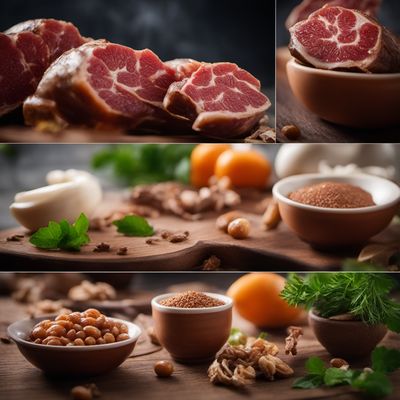
Ingredient
Horse carcase
The Noble Beast: Horse Meat
Horse carcass is a lean and tender meat with a deep red color and a distinct flavor that is often described as slightly sweet and gamey. It has a fine texture and is known for its tenderness, making it suitable for various cooking methods such as grilling, roasting, or braising. Horse meat is commonly used in traditional dishes like steak tartare, sausages, and stews.
Origins and history
The consumption of horse meat dates back thousands of years and has been a part of many cultures' culinary traditions. It has been consumed in countries such as France, Italy, Japan, and Kazakhstan, where it is considered a delicacy. Horse meat was historically consumed due to its availability and nutritional value, as it is a good source of protein, iron, and vitamins. However, its consumption is controversial in some regions due to cultural, ethical, or religious reasons.
Nutritional information
Horse meat is a good source of protein, iron, and vitamins such as vitamin B12. It is also relatively low in fat compared to other meats, making it a lean option for those looking to reduce their fat intake. However, it is important to note that horse meat may contain higher levels of cholesterol compared to other meats.
Allergens
Horse meat may cause allergic reactions in individuals with specific meat allergies. It is important to consult with a healthcare professional if unsure about any potential allergens or sensitivities.
How to select
When selecting horse carcass, it is crucial to ensure that it comes from a reputable source that follows proper animal welfare and food safety standards. Look for meat that is fresh, with a deep red color and minimal odor. It should be properly labeled and sourced from trusted suppliers or butchers.
Storage recommendations
To maintain the freshness and quality of horse meat, it is essential to store it properly. Keep it refrigerated at temperatures below 40°F (4°C) to prevent bacterial growth. If not consumed within a few days, it is advisable to freeze the meat to extend its shelf life. Proper packaging, such as vacuum-sealed bags or airtight containers, can help preserve its flavor and prevent freezer burn.
How to produce
Producing horse meat requires specialized knowledge and facilities for raising and slaughtering horses. It is best left to professional farmers and butchers who adhere to strict regulations and guidelines. It is not recommended for amateurs to attempt producing horse meat at home.
Preparation tips
Horse meat can be prepared in various ways, depending on personal preferences and cultural traditions. It can be grilled, roasted, or braised to enhance its natural flavors. Horse meat is commonly used in dishes like steak tartare, sausages, and stews, where its tenderness and unique flavor shine. It can also be thinly sliced and enjoyed raw in dishes like carpaccio or sashimi.
Culinary uses
Horse meat is commonly used in traditional dishes in countries such as France, Italy, Japan, and Kazakhstan. It is often incorporated into dishes like steak tartare, sausages, stews, and cured meats. Additionally, it is enjoyed raw in dishes like carpaccio or sashimi in certain culinary traditions.
Availability
Horse meat is commonly available and consumed in countries where its consumption is culturally accepted, such as France, Italy, Japan, and Kazakhstan. However, it is important to note that the availability of horse meat may vary depending on local regulations and cultural preferences.
More ingredients from this category » Browse all

Turkey carcase
The Versatile Turkey Carcase

Bovine carcase
The Foundation of Flavor

Wild boar carcase
Untamed Bounty: Wild Boar

Goat carcase
The Wholesome Base

Duck carcase
The Essence of Duck: Unveiling the Secrets of Duck Carcase

Chicken carcase
The Foundation of Flavor: Unleashing the Potential of Chicken Carcase

Deer carcase
Venison: The Wild Delicacy

Rabbit carcase
The Art of Rabbit: Unlocking the Culinary Potential of Rabbit Carcass

Asses-mules-hinnies carcase
The Forgotten Meat

Goose carcase
The Flavorful Foundation

Pig carcase
Pig Carcase: A Versatile Ingredient

Sheep carcase
The Art of Lamb: Exploring the Versatility of Sheep Carcass